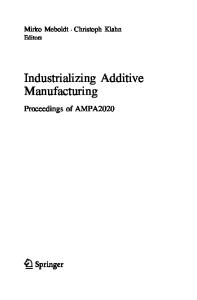Particle-scale numerical modeling of thermo-mechanical phenomena for additive manufacturing using the material point met
- PDF / 2,044,197 Bytes
- 11 Pages / 595.276 x 790.866 pts Page_size
- 74 Downloads / 312 Views
Particle-scale numerical modeling of thermo-mechanical phenomena for additive manufacturing using the material point method Takashi Maeshima1
· Youngkyu Kim1 · Tarek I. Zohdi1
Received: 30 March 2020 / Revised: 20 August 2020 / Accepted: 3 September 2020 © OWZ 2020
Abstract A fundamental numerical model at the powder particle scale based on the material point method (MPM) is developed for selective laser sintering (SLS). In order to describe the thermo-mechanical phenomena, a laser heat source model with a Gaussian energy distribution and the Perzyna viscoplastic model with a return mapping algorithm are employed. The principal process conditions, such as the laser power and radius, and the scanning speed are systematically varied. Based on the obtained temperature distribution generated by laser irradiation under these conditions, elastic–viscoplastic stresses were calculated to evaluate the deformation of powder particle pairs under the driving force of surface tension via a simple two-dimensional test case. The developed MPM model can capture minute changes of the deformation behavior and the temperature distribution history during melting and consolidation at the particle scale. Melting and consolidation of particle pairs during SLS are basic nature in determining the final product quality. The model can help to evaluate variations in the fusion of microscopic areas, melted by a laser, resulting from variations in the process conditions. Keywords Material point method · Particle-scale modeling · Additive manufacturing · Viscoelasto-plastic model
1 Introduction Selective laser sintering (SLS) and selective laser melting (SLM) are laser fusion additive manufacturing (AM) processes that have attracted attention in recent years due to the ability to achieve high design flexibility to create unprecedented components. These processes are layer-by-layer processes, in which the laser selectively melts the powder layer in accordance with two-dimensional (2D) slice data generated from three-dimensional (3D) computer-aided design models. Accurate melting of the predetermined microscopic region at the powder particle scale will create high-quality AM parts. To control the melting in such microscopic regions, the optimal powder characteristics and process input paramT. Maeshima and Y. Kim authors are contributed equally to this work.
B
Takashi Maeshima [email protected] Youngkyu Kim [email protected] Tarek I. Zohdi [email protected]
1
University of California, Berkeley, Etcheverry Hall, Berkeley, CA 94720-1740, USA
eters need to be determined, which requires expensive and time-consuming trial-and-error experimental approaches. An attractive alternative to answering this challenge is through a numerical modeling approach. Numerical models can help manufacturers achieve a better prediction on the behavior of a powder melting process to control a microscopic region and determine powder specification and process parameters. Several works have been done to model the metallic powder melting process in mesh
Data Loading...











